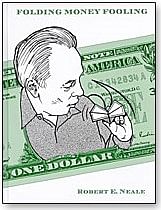Folding Money Fooling by Robert E. Neale
Reviewed by Jamy Ian Swiss (originally published in Genii October, 1997)

If I was one of the many magicians who loved puzzles and origami—and I'm not—or if I
even suspected that I might someday want to be, I would immediately buy this charming
new book by Robert Neale. Mr. Neale is something of a celebrity in the Venn diagram
overlap between magic and origami, not to mention its special subset utilizing paper
money. He is the inventor of the incomprehensibly cute "Bunny Bill," an extraordinary
construction which manages to fold a dollar bill into the form of a top hat from which,
when squeezed, pops up a simulacrum of a bunny head, ears and all. I am not making
this up.
The Bunny Bill has been around a long time, marketed as a manuscript from Magic,
Inc., who have kindly granted permission to include it in this volume, already a giant
step toward providing significant value to the reader. Those instructions have also been
updated with some further details concerning the folding of the ears, the original
description of which apparently leaned rather heavily on the imagination of the reader.
How good is the Bunny Bill? Mr. Neale tells us that Paul Harris, long a Bunny Bill fan
and master folder, "has done an entire evening of walkaround performances using only
the Bunny Bill." I am not making this up.
But there's much more to be found in these pages. In addition to three entries
concerning the Bunny Bill and variations, there are eighteen other items, divided among
more animated folds, puzzles, and tricks. The animations include such items as a
Fluttering Butterfly, a hopping "Billfrog," and a Perching Parrot. The tricks aren't quite
in the miracle class, but they do contain some surprises, including bills that stretch;
changing George Washington's expression; turning a basket into a much larger snake;
puncturing and restoring a bill; and a lovely variant of the classic marketed effect Skull
Location, in which a bill is folded into a small head-like shape with a mouth that opens
and closes, and then, "When a small packet of cards is held in the mouth and shaken, all
fall away except the previously chosen card." I am not making this up.
You have to admit that folding an animated toy or puzzle or magic trick out of a
common dollar bill has a much better chance of branding you the coolest guy in your
peer group—as opposed to annoying people with the social geekery of a poorly-executed
duck-and-deal card trick. (Okay, that may be a false dichotomy.) So the only remaining
question is: How hard is it to learn this stuff? Because, of course, if it's much harder
than replacing the rubber band on a folding quarter, we're going to lose at least a few
students right there. Well, while this stuff isn't exactly effortless—and goodness knows
you don't want to get me started on that tangent again—it does seem like it would be
remarkably easy to master many if not most of these constructions. There is no doubt whatsoever that this book has been a demanding collaboration between the
author/inventor, the illustrator, and the publisher. The explanations are written with
superb clarity, and the drawings, done by the estimable Earle Oakes, are magnificently
detailed, generously sized and voluminous in number and some of them, like a sequence
on page 125, are so filled with life as to be simply beautiful. I also like the design of the
binding in its choice of color and font (although I wish the publisher would spring for
cloth instead of vinyl bindings), but the efforts of all parties involved seem to have come
to a crashing stop at the threshold of the dustjacket, which is, I think it fair to say, a
failure. Perhaps this last element will improve in the proposed second volume, whose
appearance you can help to assure by buying your own copy of this book, not borrowing
it from a friend.
One practical question which interested me was how long it might take to execute these
models after sufficient practice has been invested to achieve reasonable proficiency.
Although I would have liked to have seen such information included in the book, in a
conversation with Mr. Neale, he said that while many might be somewhat time
consuming if folded from scratch—i.e., a couple of minutes—that the real secret to
making practical use of most of these forms is to prefold them, then unfold and refold
them in front of your audience. People will tend to be very interested in watching the
folding process, and refolding the forms along the preexisting creases means that,
according to the author, most of these constructions can be refolded in about 30 seconds
or thereabouts, an encouraging and perfectly practical time for real-world use and
"performance."
Regarding performance, the author has also provided sample scripts—some
appropriately brief, and some quite effectively more elaborate—for turning most of these
items into charming moments of theater. I really think he's onto something here, given
the combined novelty and intrigue of paper money, origami skills, entertaining
constructions and presentational accompaniment. I would encourage readers to try
their hands at this, as well as to perhaps introduce younger potential folding
enthusiasts. Many of these items are certainly manageable for kids in the range of eight
or ten years old in my estimation. After all, I actually folded every one of these forms
just to write this review! Okay, I made that up.

